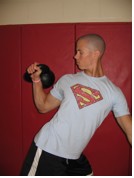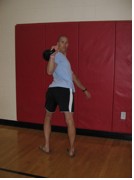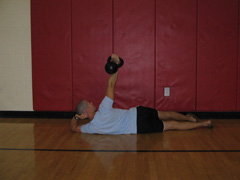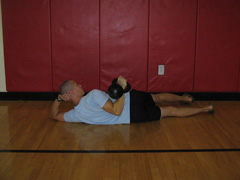Latitude
Tim Anderson, RKC2
September 18, 2008 01:05 PM
One of the reasons I fell in love with kettlebells is that they helped me discover my lats. I knew I had to have them; I just couldn't make them flare out. Not only that, I only tried to use my lats for pulling, I never tried to harness their awesome strength for pressing. Kettlebells have changed all of that. Now I no longer have to suffer the disgrace of ILS (imaginary lat syndrome — courtesy of Brett Jones, Master RKC).
The lats are so crucial for a proper kettlebell press. Learning how to tighten the lats and use them to push up the kettlebell will allow you to press some serious weight. It will also help protect your shoulders from injury. Using the lats to pull the kettlebells back down from a press will also greatly increase your strength. In fact, the lats are probably the most used muscles in all the kettlebell drills. They hold your shoulder down in the socket in snatches, presses, windmills and get-ups. They keep your shoulders connected to your body in swings and snatches. And, if you are pressing properly, it's your lats that are doing most of the work. They even take the heat in the kettlebell rack position. I can't think of a kettlebell exercise where the lats are not a major player. This is good news for those with ILS!
Occasionally I'll have a client who just can't quite figure out how to engage their lats when performing kettlebell presses. The kettlebell lifts that really helped me find my lats and harness their power were the side press and the bent press. Squeezing my "arm pit muscles" and bringing my elbow behind my back really made my lats rise like hot air balloons. Unfortunately, if the bent press is the first exercise your client ever sees you perform; they'll probably head for the door. The side press however could be a great tool in helping your victim find his/her lats. It is less pretzel-like and more press-like. It also allows your client to press a heavier weight. With the side press, a heavier weight can really wake up the lats.
If however, a person still has trouble finding their lats with the side press, they might try the arm bar press. The arm bar press, as the name suggests, starts out like the arm bar. Lie down and grab a kettlebell and press it up as if you were going to perform a Turkish get-up. Roll to your side so that the kettlebell stays pointed to the sky and your arm stays perpendicular to the floor. This is the arm bar position. You may prop your head up with your other hand if you like. Now tighten up your body, squeeze the bell and slowly, with tension, pull the bell down allowing your elbow to go behind your back. Pull your elbow down as far as you comfortably can. Feel your lat yet? It should be about to burst. Now, using that same tension and your newly bulging lat, you will press the bell back up to the arm bar position. Congratulations! You've found your lat. Do this a few times a week and you'll quickly learn how to engage your lats for all your other lifts. Then you will develop real latitude.


For the side press, squeeze your arm pit muscles and rotate your elbow behind your back as far as you comfortably can. Your lat will pop.


For the arm bar press, squeeze the bell, tighten up and pull your elbow down, behind your back as far as you comfortably can. Now use that lat to press the bell back up!
Tim, RKC II, is firefighter and kettlebell instructor near Raleigh, NC. He has been a personal trainer for 10 years and loves the opportunity to infect people with kettlebells. Tim can be reached through his website at www.TAsfitness.com .
Back